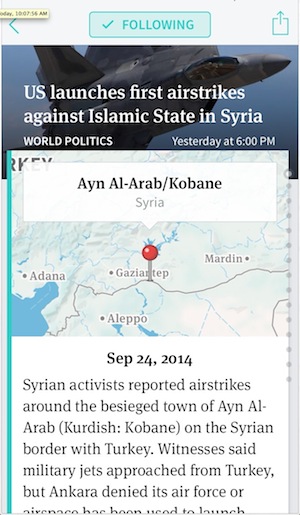
What does it mean to follow the news? What does it mean to follow a story? That’s the question that the third iteration of Circa’s news app, out today, wants to help users answer.
 Circa is in an interesting position. On the one hand, they’re industry darlings — partially credited with popularizing the card, they are almost always on the short list when people ask about innovative mobile news apps. It has major Silicon Valley cred. In 2013, Apple listed it among their best apps, and its App Store user rating is a respectable four and a half stars. When international news execs come to the United States to see what’s happening here, Circa is on their mind.
Circa is in an interesting position. On the one hand, they’re industry darlings — partially credited with popularizing the card, they are almost always on the short list when people ask about innovative mobile news apps. It has major Silicon Valley cred. In 2013, Apple listed it among their best apps, and its App Store user rating is a respectable four and a half stars. When international news execs come to the United States to see what’s happening here, Circa is on their mind.
At the same time, it’s unclear how much actual use it’s getting. Circa has been unwilling to release user numbers ever since launch. As of this morning, it ranked 71st among the free news apps on the App Store, behind apps for the Philadelphia ABC affiliate and Long Island’s News 12. While the concepts are interesting, whether Circa can build the wide user base they’re looking for is unclear.
“We built it for us. We built it for people who were on the go, and needing to be informed,” says Circa CEO Matt Galligan. “What it’s become is much more broad than that.”
Circa allows users to “follow” a story — to be notified with small updates as they come in — but Galligan says defining that new behavior for users has been a challenge. In addition, some users followed “well over a thousand stories,” which made notifications messy.
“The way we had previously presented these updates was a list of stories that happened to have updates. We would show you a list of stories that contained mentions of something you followed,” Galligan says. “We saw an opportunity to streamline and break it down into a solitary feed. Instead of having to dip into every story, you have one feed to look through.”
That single feed is called Wire. (Galligan says the team felt the product was different enough from The Atlantic’s now deceased The Wire — and presumably the song, the TV show, and the band — to warrant the similar name.) Circa keeps track of what topics you’re interested in, what stories you follow, and what you have and haven’t read and provides granular updates accordingly. For example, I follow the story “U.S. launches first airstrikes against Islamic State in Syria” and got an update at 9:43 a.m. today about reported airstrikes in a town called Ayn Al-Arab near the Turkish border.
“All we have to do is drop one new update,” says Galligan. “Any other traditional publication would have to write a prerequisite amount of words.”
The new version of Circa also has a feature called Daily Brief, a headline rundown that users can customize and set to reload at a certain time. Galligan says the idea was inspired by the daily presidential brief and not, as I would have suspected, by Quartz’s popular Daily Brief email newsletter.
 “The idea that we know what you’ve read and know what you haven’t is truly the ultimate personalization,” says Galligan. Indeed, that the user can control what stories they see in the stream and which they get via notification is useful. Galligan says personalized push notifications (notifications that users asked for) draw more traffic to a story than generalized ones (notifications that everyone gets automatically). Other new features like search make it even easier to locate and follow the stories you want to stay up to date on.
“The idea that we know what you’ve read and know what you haven’t is truly the ultimate personalization,” says Galligan. Indeed, that the user can control what stories they see in the stream and which they get via notification is useful. Galligan says personalized push notifications (notifications that users asked for) draw more traffic to a story than generalized ones (notifications that everyone gets automatically). Other new features like search make it even easier to locate and follow the stories you want to stay up to date on.
Josh Stearns, who’s written about Circa in the past, has been beta testing the new version. “The app makes it easy to skim across topics and then drill down into stories and follow a few threads within Circa or on to other people’s sites,” he says. “In that way, it reminds me a bit of many of the newsletters I like, or the new Quartz homepage.” Circa allows users to both skim general news headlines and get constant updates on stories they’re following, which Stearns says could appeal to both news junkies and average news consumers.
With the new app launched, the next mission for Circa is a revamp of its CMS, which is highly customized but has operated in roughly the same way for two years. The app is known for its use of cards to make reading easier and granular news updates more intuitive, but that approach may not define Circa forever. “We may not stick with the cards. There are some interesting things we’re thinking about that would move us beyond cards, that would retain the atomized approach,” Galligan says.
What’s in store for Circa’s CMS is especially important as they move towards building a business plan for the app. Galligan says they’re in talks — “active discussions with news organizations that would be complementary to our brand and to our audience” — about what their system could provide to other media companies. (Whether that would mean content partnerships or software licensing, Galligan wouldn’t say.)
Circa brought on former Tumblr president John Maloney to help develop their business in April. Galligan says that, in addition to experiments with the technology, that plan will definitely involve advertising — a development that’s especially interesting because, to achieve success, Circa’s active user numbers will need to impress.
“It’s not that the numbers aren’t good, it’s just a matter of neither of those things matter to us yet,” says Galligan. “Sometime, over the next six to nine months, those numbers will start to come out.”